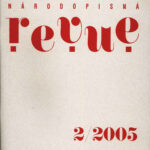Journal of Ethnography 2/2005 is focused on social groups. In his study, Igor Nosál deals with issues of childhood (“Discourses on Childhood in the Age of Postsocialism”); Ľubica Herzánová is interested in old age and growing old. What are the possible borders of old age? She has looked for the answer from several points of view, and also interviewed some inhabitants of Bratislava and Vienna (“The Trouble is that Old Age is not Interesting until One Gets there; a Foreign Country with Unknown Language”). Andrea Šalingová focuses on women-entrepreneurs in the Slovak countryside (“Tiny, Little, Harmless; Special Family Characteristics of being in Business in a Rural Location”). Jana Poláková and Helena Danielová inform about their gender research of Romany women, a project which is run by the Museum of Romany Culture in Brno (“The Roots; Gender Research of Romany Women”).
The picture supplement carries photo documents on old age and growing old, and questions the possibilities of such visual images. The Transferring Tradition column focuses on the production of birch-rods in the Moravian Wallachia, and follows its reflections in titles and names (writen by Daniel Drápala); it also focuses on the activities of collector and musician Vladimír Baier within folk music tradition in the region of Chodsko (written by Jaroslav Fiala). Social Chronicle notes the birthday of folk singer Václav Harnoš (b. 1930), and carries obituary notices: for folk musician Emil Miškeřík (1916-2004), folklorist and musician Jaroslav Jurášek (1925-2005), and ethnologist Ludvík Kunz (1914-2005). Apart from the regular conference and exhibition reports and book reviews, the discussion column focuses on the new form of Folklorika, the TV review on folk culture.



